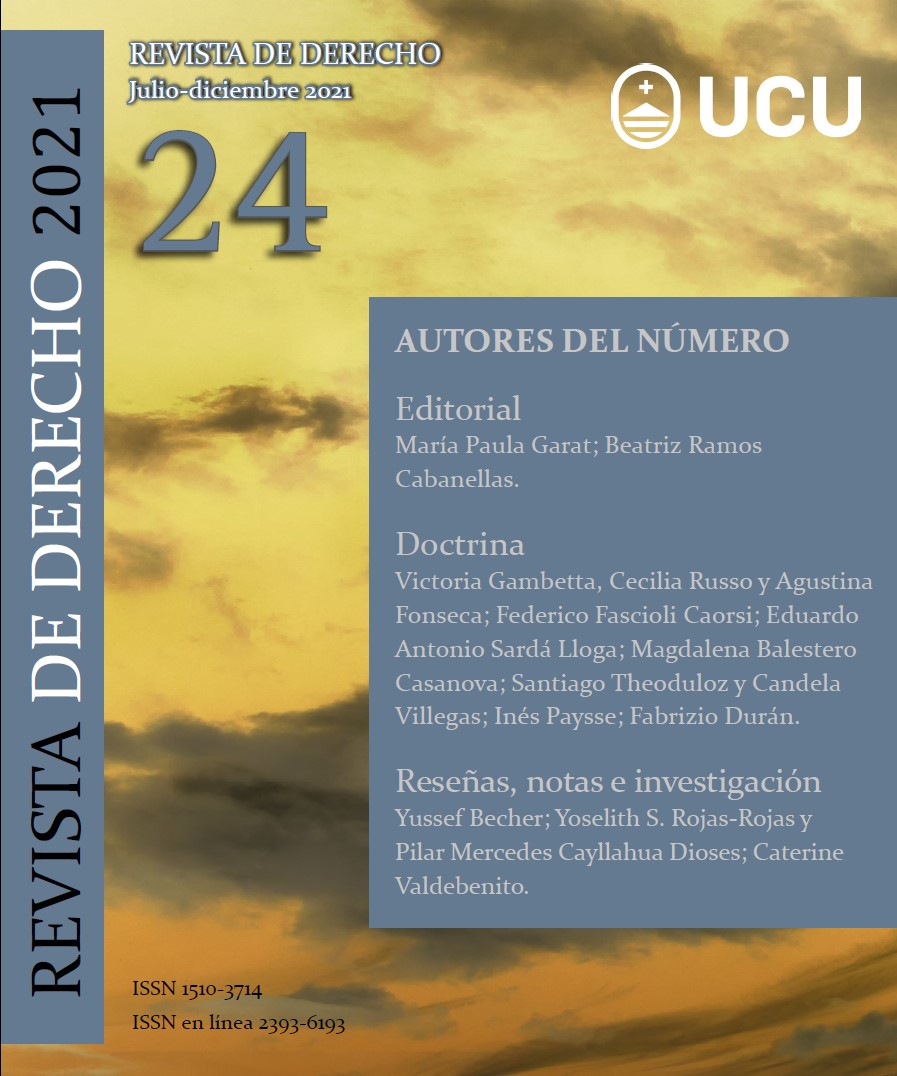The Security Interest as another way to access credit: should we regulate it in Uruguay?
DOI:
https://doi.org/10.22235/rd24.2661Keywords:
credit, security interest, secured transactions, Anglo-saxon law, pledge without transfer of possessionAbstract
The Security Interest, thoroughly regulated under article 9 of the Uniform Commercial Code of the USA, allows debtors and creditors to engage in secured transactions, where a wide range of assets may serve as collateral, avoiding the risk of a debtor’s default, thus enhancing the provision of credit. This article analyses article 9 and highlights the simplicity of this institute, stressing the difficulties and required amendments that should be made to the Uruguayan Pledges Without Transfer of Possession Act (n.° 17228) of the year 2000, which only partially imported the security interest model.
Downloads
References
Cooper, C. (2000). The New Article Nine, Uniform Commercial Code. Estados Unidos: American Bar Association.
De Cores, C. (2002). Ley de prenda sin desplazamiento. Revista de Derecho, 1(2), 85-89.
De Cores, C. (2008). El nuevo derecho de las garantías reales: Estudio comparado de las recientes tendencias en materia de garantías reales mobiliarias. Buenos Aires: Reus.
Epstein, D. G., Nickles, S. H., Smith, E. (2003). Nine Questions: Secured Debt Deals in the 21st Century. Minnesota: Thomson West.
Francia. (2006, marzo 23). Ordenanza n.° 346. Recuperado de https://www.legifrance.gouv.fr/loda/id/JORFTEXT000000639090/
Gallino, J. & Ellerman, I. (2004). Garantías mobiliarias internacionales. Anuario de Derecho Civil, 9, 67-119.
García-Valdecasas, J. A. (2017). Sobre el registro de bienes muebles y garantías mobiliarias: su futuro en España. En F. J. Valenzuela Garach, F. J. Pérez-Serrabona (Coord.), Reformas en Derecho de Sociedades (357-376). Madrid: Marcial Pons.
Groisman, C. (2019). Relevancia de la cosa futura en la contratación. Anuario de derecho civil uruguayo, 50, 825-842.
Harris, S. L. & Mooney, C. W. (2016). Security Interests in Personal Property, Cases, Problems and Materials. Minnesota: LEG.
Italia. (2016, mayo 3). Ley n.° 119. Recuperado de https://www.gazzettaufficiale.it/eli/id/2016/07/02/16G00128/sg
Naciones Unidas. (2012). Guide to Enactment of the Uncitral Model Law on Public Procurement. Naciones Unidas. Recuperado de https://uncitral.un.org/en/texts/procurement/modellaw/public_procurement/guide
Naciones Unidas. (2016). Ley Modelo de la Cnudmi sobre Garantías Mobiliarias. Recuperado de https://uncitral.un.org/es/texts/securityinterests/modellaw/secured_transactions
Organización de Estados Americanos [OEA]. (2002). Ley Modelo Interamericana sobre Garantías Mobiliarias. Recuperado de https://www.oas.org/es/sla/ddi/docs/garantias_mobiliarias_Ley_Modelo_Interamericana.pdf
Roca Sastre, R. (1968). Derecho Hipotecario. Barcelona: Bosch.
Simón, L. M. (2000). La ejecución de crédito prendario registrado en la reciente Ley 17.228. Revista Uruguaya de Derecho Procesal 1/2000.
Uruguay. (2000, enero 7). Ley n.° 17.228: Ley de Prenda sin Desplazamiento. Recuperado de https://www.impo.com.uy/bases/leyes/17228-2000
Walt, S. D. & Warren, W. D. (2019). Commercial Law Selected Statutes (2018-2019). Estados Unidos: Foundation Press.
Wonsiak, M. & Curbelo, C. (2000). Ley de Prenda, Encuentros Técnicos Regionales, Versión Taquigráfica. Montevideo: Asociación de Escribanos del Uruguay.














